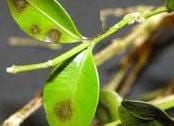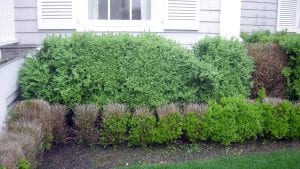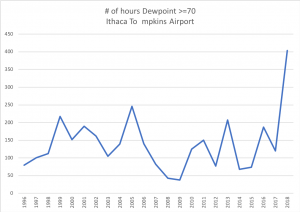Boxwood blight, Cylindrocladium buxicola, was first identified in 2011 when submitted samples were examined at the Connecticut Agricultural Experiment Station. This marked the first confirmed cases outside of the UK and New Zealand. Since then, it’s been found on many cultivars of boxwood, Buxus spp., up and down the east coast.

Now, it’s not only showing up in many downstate counties and Long Island, but completely decimating formal gardens and landscape nurseries. With various landscape and cutting uses, Boxwood is a million dollar plus industry, including its use as a major component in holiday wreaths and decorations.

While boxwood blight might not be a concern in your yard, you’d notice its loss in many landscapes. This is a major concern of landscapers, horticulturalists and growers.
Boxwood blight shows up as dark brown spots on leaves. These lesions enlarge with dark borders until they merge with others. By then an entire leaf—and many nearby—may be covered. These browned out or straw-colored dead leaves drop in record time. “That’s why they call it a blight.”
Stem infection also occurs and shows up as long black lesions. This FUNGAL DISEASE forms sporadochia (fruiting structures), visible with a hand lens. In layman’s terms, sporadochia produce sticky spores—nasty seeds of destruction if you’re a fungal disease! Spores happily spread by wind, rain, splashing water, or by hitchhiking on you, your lawnmower and rake, your dog, even your favorite garden birds.
Why this sudden outbreak? Anyone who suffered through this swampy summer can guess. According to Cornell Alum and New York State Climatologist, Mark Wysocki, “This is more typical for the Gulf Coast states.” Syracuse, for example, sweated through 531 hours when the dew point, a standard measure of humidity, was at least 70 degrees. That’s more than double the number of sticky hours of the next closest year, 2005.

With relatively new pests, IPM and conventional treatment options aren’t time-tested. Other factors such as soil health, over or under-watering and winter injury increase susceptibility, but this year’s humidity has come at a high cost to boxwood.
For more on boxwood blight, here are two great resources:
Connecticut Agricultural Experiment Station, Dr. Sharon M. Douglas
Margery Daughtery, Long Island Horticultural Research and Extension Center for Cornell University.